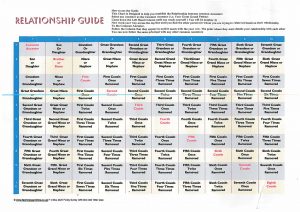
How to Know What to Call Distant Relatives
Trying to keep the blogs interesting so here it goes, isn’t it exciting to find out you have a historical icon in the far-off depths of your family tree? But when you brag to your friends, what do you call this famous ancestor?
As an example
“Oliver Cromwell is the great-uncle of my great-great-grandfather’s third cousin!”
Confusing, right? Not really
If you’re familiar with the system we use in designating these relationships, you’ll see there’s a consistent formula to the kinship titles we assign to various family members.
Since our family tree is from an English Speak background it is classified based on gender, generation, and consideration of consanguinity (direct descendants) and immediate affinal (in-law) relationships. Our common familiarity is with immediate family and direct lines, so brother, sister, cousins, aunts/uncles and the (great) grandparents. It starts to get confusing when differentiating between the “degrees” and “removals” of cousins.
First, Second, Third Cousins.
The ordinals in this system, “first cousin”, “second cousin”, “third cousin”, all describe the degree of the cousin relationship or the number of generations to their closest ancestor. For example, your second cousin is a person you share great-grandparents with and is not your direct sibling. It’s easier to think of what your shared ancestors would call you both – if your closest shared direct-ancestor is your great-great-grandparents, and they call you both “great-great-grandchildren,” then you have no removal, you two are second cousins
Once, Twice, Thrice removed…
When the cousins are not in your same generation then they are “removed. “First cousins once removed” declares that either one of you are one generation away from being first cousins. For example, if your first cousin has kids, they are your first cousins once removed – the closest common ancestor shared are your grandparents but are “once removed” from the level of first cousin (held by their parents).
Here is the confusing part: there are two instances in your family tree that can share this title. This reflects what cousins refer to each as. Up until now, each relationship in your family tree has inverse titles for each other. You are your aunt’s niece or nephew; you are your great-grandparents grandchild. Cousins refer to each other as cousins. Because of this, your first cousin’s kid is your first cousin once removed and you (the parent of their second cousin) are also their first cousin once removed – you each refer to each other as the same. This means that the child of your first cousin and the parents of your second cousin are both “first cousins once removed” despite each of them being generations apart.
Here is the breakdown:
- FIRST COUSINS: Non-siblings that share grandparents
- SECOND COUSINS: Non-siblings that share great-grandparents
- THIRD COUSINS: Non-siblings that share great-great-grandparents
- FIRST COUSINS ONCE REMOVED: Two people for whom the first cousin relationship is one generation removed
- FIRST COUSINS TWICE REMOVED: Two people for whom the second cousin relationship is two generations removed
See the chart below and see if you can work things out

still doesnt say what is considered a distant cousin though
check the chart at the very bottom.
That’s what I’m saying
A “distant cousin,” also known as a collateral cousin, is a family member with whom you share a common ancestor, often many generations back. Close cousins are, by contrast, cousins one is likely to be acquainted with, descendant’s of one’s own grandparents, for example, the children of your aunts and uncles.
The further back you go the more distant the cousinship. Third cousins will only share your 2 x great grandparents, and your fourth cousin will only share your 3 x great grandparents.